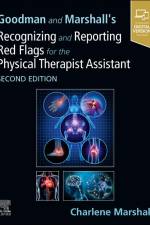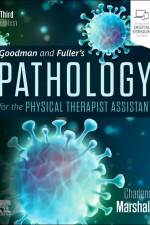av Charlene Marshall
857
Goodman and Marshall's Recognizing and Reporting Red Flags for the Physical Therapist Assistant, 2nd Edition, helps you develop essential skills for recognizing signs and symptoms that can compromise patient care. It presents a consistent, three-step model for monitoring patients for red flags relating to neuromuscular and musculoskeletal problems, medical diseases, side effects of medications, and other co-morbidities that may be unknown to the PT. Combining the insights of a physical therapist and a physical therapist assistant, this resource is unmatched in providing clear guidelines for finding and documenting red flags. NEW! eBook version is included with print purchase, allowing access all the text, figures, and references, with the ability to search, customize content, make notes and highlights, and have content read aloud. Plus, Patient Scenarios and Review Questions are included in the eBook included with print purchase. UPDATED! Revised content throughout provides the most current information needed to be an effective practitioner. UPDATED! References ensure content is current and applicable for today's clinical practice. Coverage of warning flags includes red and yellow flags, risk factors, clinical presentation, signs and symptoms, helpful screening clues, and guidelines for communicating with the PT, allowing you to quickly recognize the need for any re-evaluation of the patient. Three-step approach to formative assessments of physical therapy patients provides a consistent way to watch for and report on adverse changes such as range of motion, strength, pain, balance, coordination, swelling, endurance, or gait deviations. PTA Action Plans show the clinical application of text material relating to observing, documenting, and reporting red (or yellow) flags to the physical therapist. Clinically relevant information includes the tools needed to monitor the patient's response to selected interventions, and accurately and quickly report changes to the supervising PT. Cognitive processing-reasoning approach encourages you to gather and analyze data, pose and solve problems, infer, hypothesize, and make clinical judgments, so that you can notify the supervising PT of clients who need further evaluation or may require a referral or consultation with other health care professionals. Case examples and critical thinking activities connect theory to practice, showing the role of the PTA and how the PTA can integrate clinical observations with clinical reasoning skills. Picture the Patient sections address what to look for when assessing or working with patients, especially typical red flag signs and symptoms of emerging problems. Full-color illustrations and design clearly demonstrate pathologies and processes and make lookup easier in busy clinical settings. Key terminology is listed in each chapter, with each term bolded within the chapter and defined in a back-of-book glossary. Summary boxes and tables highlight key information for quick reference.


